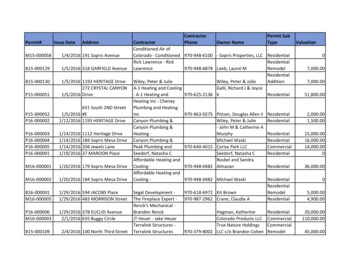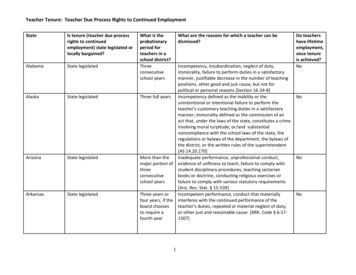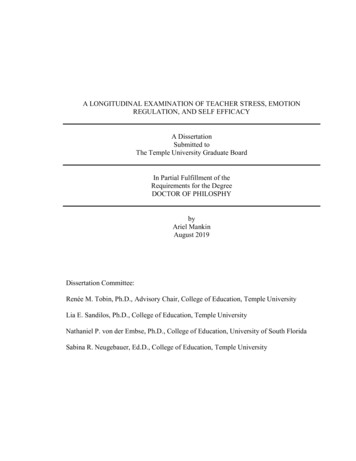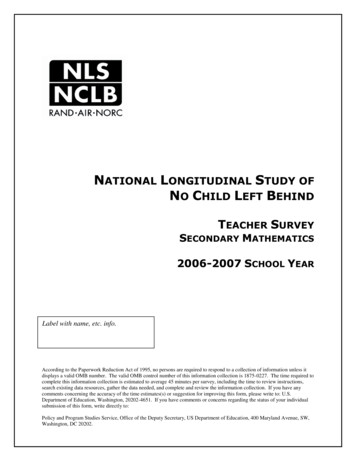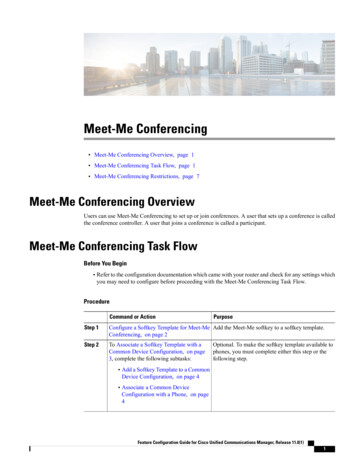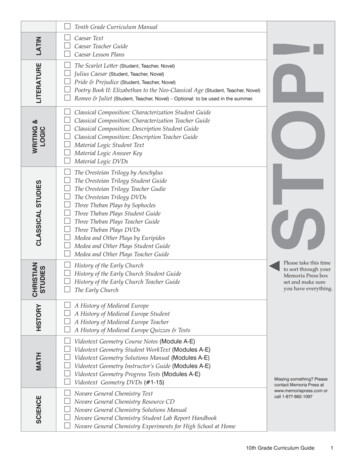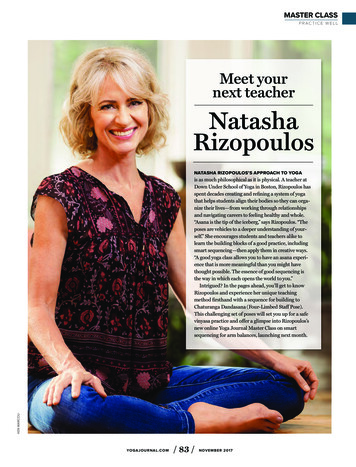
Transcription
MASTER CLASSP R AC T I C E W E L LMeet yournext teacherNatashaRizopoulosNATASHA RIZOPOULOS’S APPROACH TO YOGAKEN MARCOUis as much philosophical as it is physical. A teacher atDown Under School of Yoga in Boston, Rizopoulos hasspent decades creating and refining a system of yogathat helps students align their bodies so they can organize their lives—from working through relationshipsand navigating careers to feeling healthy and whole.“Asana is the tip of the iceberg,” says Rizopoulos. “Theposes are vehicles to a deeper understanding of yourself.” She encourages students and teachers alike tolearn the building blocks of a good practice, includingsmart sequencing—then apply them in creative ways.“A good yoga class allows you to have an asana experience that is more meaningful than you might havethought possible. The essence of good sequencing isthe way in which each opens the world to you.”Intrigued? In the pages ahead, you’ll get to knowRizopoulos and experience her unique teachingmethod firsthand with a sequence for building toChaturanga Dandasana (Four-Limbed Staff Pose).This challenging set of poses will set you up for a safevinyasa practice and offer a glimpse into Rizopoulos’snew online Yoga Journal Master Class on smartsequencing for arm balances, launching next month.YOGA JOURNAL. CO M/ 83 /NOV E M BE R 2017
MASTER CLASSP R AC T I C E W E L LMy first teacher training was co-taughtby Maty Ezraty, who was teachingAshtanga Yoga, and Lisa Walford, whois from the Iyengar Yoga method. I wasblessed to have these two very differenttraditions presented to me early on inmy yoga studies in such beautiful ways.Sometimes the two styles can seem atodds with each other, yet these twoextraordinary teachers shared a mutualrespect and presented their perspectivesin a way that never felt dogmatic. Theconversations they had about theirrespective traditions were illuminatingand inspiring. As teachers, they werenever fundamentalists, rather they wereinquisitive—asking questions like Whatdo you gain by doing something this wayversus that way?This spirit ofinquiry is theembodiment ofyoga. And theirexchanges aboutasana and yogaphilosophy informmy studies andmy teaching tothis day.practices around specific peak poses.I call my system Align Your Flow. Overthe years, I have experienced firsthandand witnessed in others how bringingorder to your physical practice can havea profound effect on your mind. Whenyou practice with alignment—when youare completely engaged by subtle intentions and actions—you become mentallyaligned as well. Your consciousnessbecomes focused and you become fullypresent: You are not just in a vinyasa flow,you’re also in a flow with yourself.I knew I wanted to teach the first timeI took a class that was truly taught. Bythat I mean, when someone teaches yogarather than just telling you which poses todo, the asana become vehicles for know-“Good sequencingallows studentsPaperback Journal 16.95From yoga luminaryand artist ElenaBrower, a journalingodyssey with morethan 150 beautifulpages to write, draw,and dream.“A soulful artistic guide.”SHIVA REA“A heartfelt offering.”SHARON GANNON“What a treasure.”DANI SHAPIROto leave class feelingbalanced—energeti-My personal practice has morpheddramatically. For10 years, I practicedAshtanga daily.I loved the repetition of sequencesthat graduallyevolve over time; how things that initiallyseemed impossible, five years later werewithin reach. And I loved the linking ofbreath and movement—the emphasis onthe classical vinyasa: Chaturanga, UrdhvaMukha Svanasana (Upward-Facing DogPose), and Adho Mukha Svanasana(Downward-Facing Dog Pose).cally, physically, andmentally.”Over time, however, the practice created some wear and tear on my body.I found myself attending more and moreIyengar classes. I loved the sequencing,the use of props, the themes, and all thedifferent ways the teachers modifiedasana for different students so that theyweren’t doing cookie-cutter versions ofposes. Eventually, my home practice andmy teaching became an amalgam ofAshtanga and Iyengar. I started themingmy classes, using props, and designingYOGA JOURNAL.CO M/ 84 /NOV E M BE R 2017ing yourself better—your anatomy, howyou interact with the world, and yourmental and physical habits. It’s ironic thatthe better you are taught a pose, and thedeeper your relationship with it becomes,the less you ultimately care about the poseitself. Instead, you understand that thepose takes you on a journey and you’realong for the ride no matter what. You’rein a relationship with that pose, on gooddays and bad days. I believe that skillfulteaching brings you to life. It makes youcare about what matters, makes you interested in actions, not results. And that’svery different from someone simply calling out a pose.A well-sequenced class can also helpstudents better understand the benefitsof each pose. Good sequencing unlockscontinued on page 86
MASTER CLASSP R AC T I C E W E L Lcontinued from page 84postures. For example, a hard pose thatmay otherwise seem elusive or inaccessible becomes doable because of where itlands in a sequence (what came beforeit); the pose comes into focus in a waythat it may not have otherwise. Goodsequencing allows students to leave classfeeling balanced—energetically, physically, and mentally. In contrast, a poorlysequenced class feels physically confusing and energetically unbalanced: It canfeel like the rest of your life when yourlife isn’t going quite as you’d like.Let nature beyour teacher.—William WordsworthEarn a graduate degree innatural medicine.Yoga Therapy Holistic Nutrition Herbal MedicineHealth Coaching Health Promotion AcupunctureOnline and On Campus Programswww.muih.edu 800-735-2968FindMy new favorite StudioLearning good sequencing will giveyou freedom to be creative based onsound principles of anatomy and alignment. If you’re a teacher, you’ll be able tochange a sequence in the moment basedon who is in the room or how your students are responding to your class. Onceyou understand how to organically buildtoward a peak pose, you can modify ortailor your class based on what yourstudents need more or less of in orderto make progress. One common mistaketeachers make is to memorize a sequenceand rigidly adhere to it without assessinghow it is being received or processed.Another is building toward a peak andthen saying “OK, time for Savasana(Corpse Pose).” Prepare your studentsto be quiet at the end of class in the sameway you prepare them for a demandingpose. One of my most important jobsas a yoga teacher is to give students agood Savasana.LEARN MOREYoga Journal’s newonline Master Class program brings the wisdomof world-renowned teachers to your home-practicespace, offering access toexclusive workshops witha different master teacherevery six weeks. In December, Natasha Rizopouloswill share her sequencingmethod for success in armbalances. If you’re ready toget a fresh perspective andmaybe even meet a lifelongyoga mentor, sign up forYJ’s yearlong membershipat yogajournal.com/masterclass.YJ D I R E C TO R Y. CO MSearch for Studios, Events TeachersYOGA JOURNAL.CO M/ 86 /NOV E M BE R 2017
MASTER CLASSPHOTOS: KEN MARCOU; MODEL: NATASHA RIZOPOULOS; HAIR/MAKEUP: SONJA GJOKAJ; CLOTHING: MODEL’S OWNP R AC T I C E W E L LA smart start to vinyasaSecure thefoundation fora safe vinyasapractice withthis thoughtful,challengingsequencefrom NatashaRizopoulos.GOOD SEQUENCING IS LIKE A GOOD BOOK: Ithas both narrative and energetic arcs. This meansyour sequence begins somewhere strategic, it proceeds progressively and methodically toward a peakpose, and then it cools down from that peak towardSavasana. Along the way there are groups (or chapters) of poses that work together logically to revealthe peak pose. Even within each chapter there is amini peak of sorts—a challenge that the sequencehas prepared you for.I teach this storytelling method of sequencingby introducing what I call essential elements—movements that lengthen, strengthen, or bringawareness to a body part that needs attention inorder for a peak pose to be fully realized. The goalis to introduce these essential elements early on inyour sequence, under the simplest circumstancespossible, so you can practice them without distraction, then continue to revisit them in graduallymore demanding ways as the sequence continues.YOGA JOURNAL. CO M/ 89 /In the following practice, we’ll work on the essential element of drawing the heads of the upperarms back in Tadasana (Mountain Pose). Thenwe’ll apply this alignment in progressively moredifficult poses—Bhujangasana (Cobra Pose),Chaturanga, and Upward-Facing Dog Pose—overtime setting the foundation for more difficult armbalances, like Bakasana (Crane Pose) and EkaPada Koundinyasana (One-Footed Pose Dedicatedto the Sage Koundinya). As you practice, hold eachpose for as long as needed in order to discover andimprint the actions and alignment that inform it—this may take between 5 and 20 breaths, depending on the difficulty of the pose. Practice a softand steady Ujjayi Pranayama (Victorious Breath),noticing how the inhalations can create space andopenness (especially in the chest) and how theexhalations tend to anchor and lift the lower belly.Observe how each of the poses builds on the posethat came before it.NOV E M BE R 2017
MASTER CLASSP R AC T I C E W E L L12TADASANA Mountain PoseTADASANA WITH CHATURANGA DANDASANAARMS Mountain Pose with Four-Limbed Staff Pose ArmsStand with your big toes touching and your heels about an inchapart. Pull your inner arches up while pressing your big-toemounds down. Engage your quadriceps without locking yourknees. Press your femurs back while gently releasing your tailbone down. The right balance of these two actions will createa subtle lift in the pit of your abdomen and support the naturalcurve of your lower back. Draw the heads of your upper armsback so they align with the sides of your body. We will explorethis Tadasana shoulder alignment throughout this sequence.Maintaining the actions from Tadasana, bend your elbows tocreate right angles with your arms. If you allow your elbowsto splay outward, the heads of your upper arms will collapseforward, closing the fronts of your shoulders. Instead, pin yourelbows into your midline to help pull your upper arms backward.Keep your forearms parallel to the floor and draw your handsbackward to extend your wrists—Chaturanga arms. Notice thatyou are still practicing Tadasana shoulders.34TADASANA WITH URDHVA MUKHA SVANASANAARMS Mountain Pose with Upward-Facing Dog Pose ArmsBHUJANGASANA WITH CHATURANGAARMS Cobra Pose with Four-Limbed Staff Pose ArmsHold your Tadasana shoulders and wrist extension as yourelease your forearms to your sides. Your arms should forma straight line that is perpendicular to the floor. Continue todraw the heads of your upper arms backward. This is yourUp Dog arm position; you are still maintaining Tadasana shoulders. In other words, Tadasana shoulders are also Up Dog andChaturanga shoulders. Preserving the integrity of this alignmentis key to maintaining healthy shoulders in a vinyasa practice.Come to your belly with your legs extended and your feet hipwidth apart. Place your hands beside your lower ribs with yourwrists beneath your elbows. Roll the heads of your upper armsback and up until your shoulders are at elbow height. Pin yourelbows into your midline, engage the muscles of your upperback, and press your hands into the floor to help you find thisalignment. With your arms forming right angles, notice that theheads of your upper arms are in Tadasana position.YOGA JOURNAL.C O M/ 90 /NOV E M BE R 2017
MASTER CLASSP R AC T I C E W E L L56CHATURANGA WITH A STRAP HAMMOCKCHATURANGA WITH BLOCKSTo find safe shoulder alignment in Chaturanga, make a strap loopseveral inches wider than your shoulders. Put the strap aboveyour elbows and come into Plank Pose, splaying your elbowsto prevent the strap from falling. Practice Tadasana actions: rootdown with your big-toe mounds, lift the tops of your thighs, andrelease your tailbone down. Then, exhale to bend your arms,pulling your chest forward and pushing your heels back, movinginto Chaturanga with the strap supporting your ribs. Your shoulders should be in line with your sides—Tadasana shoulders!Another way to find safe alignment and build strength in thispose is to use a pair of blocks. Place them upright and shoulderwidth apart at the front of your mat. From Plank Pose, with yourfingertips 1–2 inches from the blocks, revisit Tadasana actions:big-toe mounds, thighs, and tailbone. Come into Chaturanga bypulling your chest forward, pressing your heels back, bendingyour arms, and pinning in your elbows. Gently tap the blockswith the fronts of your shoulders. The heads of your upper armsare in line with the sides of your body—Tadasana shoulders.78CHATURANGAURDHVA MUKHA SVANASANAClassical Chaturanga builds on the alignment and prop workyou practiced in the previous postures. Begin in Plank Pose withyour shoulders slightly ahead of your wrists. Plug into the floorwith your big-toe mounds to activate your quadriceps, lift thetops of your thighs, and keep your tailbone heavy. Exhale intoChaturanga. Think more about pulling your chest forward thanlowering. This will help keep the heads of your upper arms in linewith the sides of your body, rather than collapsing toward thefloor. Catch yourself at elbow height. Again, Tadasana shoulders!From Chaturanga, slide your big-toe mounds back on your mat,coming on to the tops of your feet as you pull your chest forwardand up. Never let your shoulders dip lower than your elbows. Thekey action here is to move in opposite directions simultaneouslyas you transition—feet back and chest forward—so that yourbody is pulled taut and doesn’t sink toward the floor. End withyour shoulders above your wrists. Since Chaturanga and Up Dogshare the same Tadasana shoulder alignment, this sequence willhelp make the movement between the two poses more fluid.YOGA JOURNAL.C O M/ 92 /NOV E M BE R 2017
method firsthand with a sequence for building to Chaturanga Dandasana (Four-Limbed Staff Pose). This challenging set of poses will set you up for a safe vinyasa practice and offer a glimpse into Rizopoulos's new online Yoga Journal Master Class on smart sequencing for arm balances, launching next month. Natasha Rizopoulos. Meet your . next .
